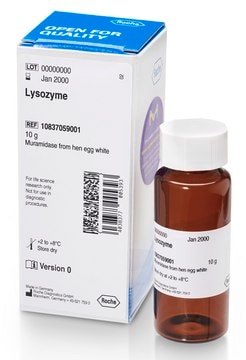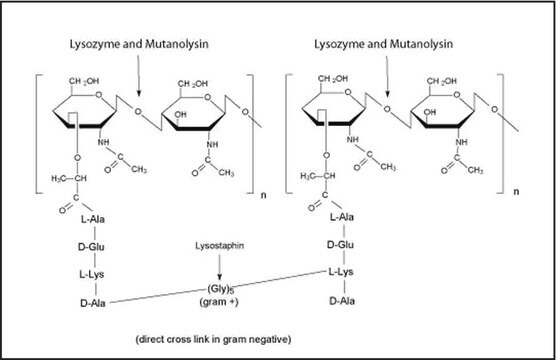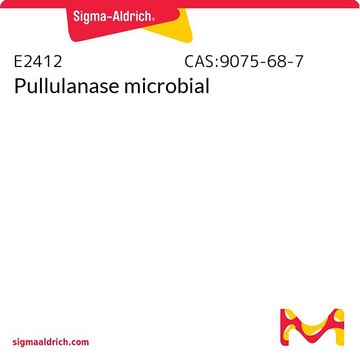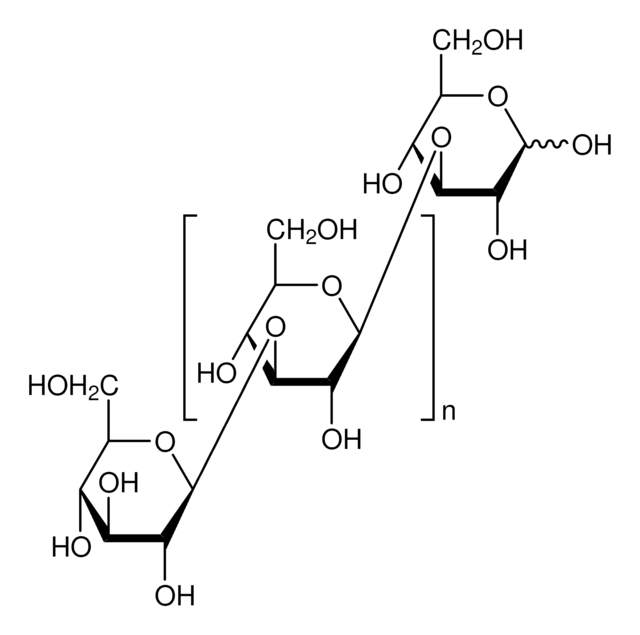추천 제품
애플리케이션
Lyticase from Arthrobacter luteus has been used for resuspending cells to extract high-molecular weight DNA for polymerase chain reaction (PCR) fingerprint analyses.
Lyticase from Arthrobacter luteus has been used:
- as a component in spheroplasting buffer to prepare yeast nuclear extracts
- for digestion in sample preparation for β-glucan enzymatic assay using yeast
- to lyse cells for RNA isolation
생화학적/생리학적 작용
Lyticase enzyme is frequently used in fungal research, particularly for species identification using polymerase chain reaction (PCR)-based techniques. It can break down β (1→3) and β (1→4) bonds between glucose units.
Lyticase is a lysing enzyme that is used to extract DNA from yeast cells by inducing partial spheroplast formation. Spheroplasts are subsequently lysed to release DNA. Lyticase is preferred to digest cell walls of yeast, which are difficult to disrupt because the cell walls may form capsules or resistant spores. Lyticase contains β-(1→;3)-glucan laminaripentaohydrolase along with β-(1→3)-glucanase, protease, and mannanase activities. It is useful with yeast cells such as e.g. Candida, Debaryomyces, Saccharomyces, Saccharomycopsis, Saccharomycodes, Eremothecium, and Schwanniomyces species.
Lyticase hydrolyzes poly-β(1→3)-glucose such as yeast cell wall glucan.
단위 정의
One unit will produce a ΔA800 of 0.001 per min at pH 7.5 at 25 °C, using a suspension of yeast as substrate in a 3 mL reaction mixture.
기타 정보
View more information on enzymes for complex carbohydrate analysis at www.sigma-aldrich.com/enzymeexplorer
For R&D use only. Not for drug, household, or other uses. Please consult the Safety Data Sheet for information regarding hazards and safe handling practices.
신호어
Danger
유해 및 위험 성명서
예방조치 성명서
Hazard Classifications
Resp. Sens. 1
Storage Class Code
11 - Combustible Solids
WGK
WGK 3
Flash Point (°F)
Not applicable
Flash Point (°C)
Not applicable
개인 보호 장비
Eyeshields, Gloves, type N95 (US)
시험 성적서(COA)
제품의 로트/배치 번호를 입력하여 시험 성적서(COA)을 검색하십시오. 로트 및 배치 번호는 제품 라벨에 있는 ‘로트’ 또는 ‘배치’라는 용어 뒤에서 찾을 수 있습니다.
이미 열람한 고객
Naturally occurring novel promoters around pyruvate branch-point for recombinant protein production in Pichia pastoris (Komagataella phaffii): pyruvate decarboxylase-and pyruvate kinase-promoters
Massahi A and Calik P
Biochemical Engineering Journal, 138, 111-120 (2018)
Lisbeth Rosager Poulsen et al.
The Plant cell, 20(3), 658-676 (2008-03-18)
Vesicle budding in eukaryotes depends on the activity of lipid translocases (P(4)-ATPases) that have been implicated in generating lipid asymmetry between the two leaflets of the membrane and in inducing membrane curvature. We show that Aminophospholipid ATPase3 (ALA3), a member
Tim K Footz et al.
Human molecular genetics, 18(7), 1276-1287 (2009-01-20)
Primary open-angle glaucoma (POAG) is a leading cause of blindness worldwide. POAG is associated with a characteristic progression of changes to ocular morphology and degeneration at the optic nerve head with the loss of visual fields. Physical mapping efforts identified
E C Williamson et al.
Journal of clinical microbiology, 39(1), 47-50 (2001-01-04)
Respiratory tract colonization with Scedosporium apiospermum in patients with chronic suppurative lung disease is a significant concern for lung transplantation candidates, since Scedosporium infections occurring posttransplantation are usually untreatable. Up to 10% of patients with cystic fibrosis attending our respiratory
Ryan M Hull et al.
PLoS biology, 15(6), e2001333-e2001333 (2017-06-28)
Copy number variation (CNV) is rife in eukaryotic genomes and has been implicated in many human disorders, particularly cancer, in which CNV promotes both tumorigenesis and chemotherapy resistance. CNVs are considered random mutations but often arise through replication defects; transcription
프로토콜
This procedure may be used for the determination of Lyticase activity using Baker’s yeast as the substrate.
자사의 과학자팀은 생명 과학, 재료 과학, 화학 합성, 크로마토그래피, 분석 및 기타 많은 영역을 포함한 모든 과학 분야에 경험이 있습니다..
고객지원팀으로 연락바랍니다.










